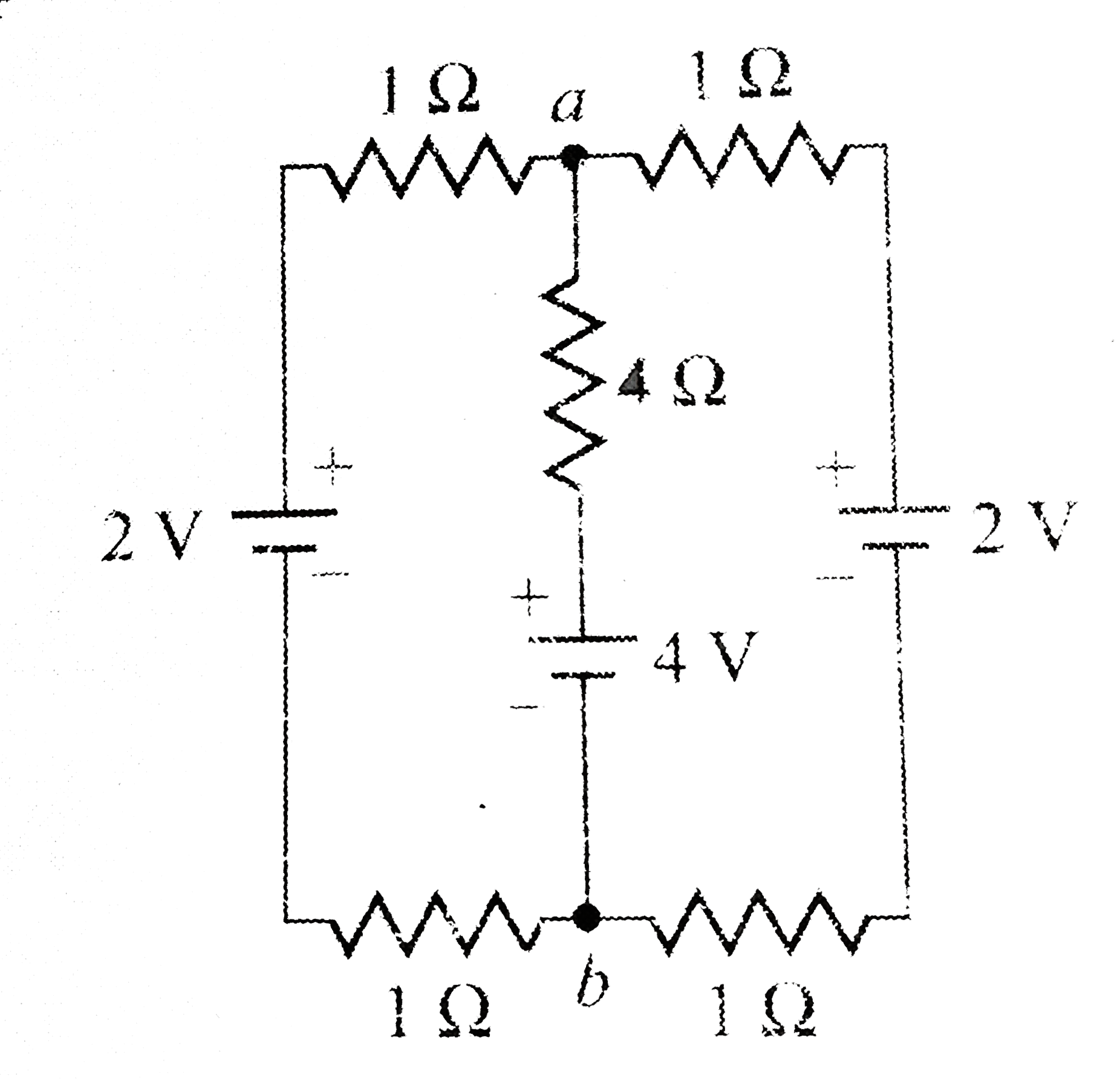Shown a part of an electric circuit, The potentials at the points a,b,and c are 30V,12V,and 2V respectively.Find the currents through the three resistors.
 Solution in Gujrati
Solution in Gujrati
Let potential at the point be x V
Then(30−x)=10i1
(x−12)=20i2
(x−2)=30i3
Sincei1=i2+i3
⇒(30−x10)=(x−1220)+(x−230)
⇒(30−x)=(x−122)+(x−23)
⇒30−x=(3x−36+2x−46)
⇒180−6x=5x−40
⇒11x=220
⇒x=22011=20V.
i1=(30−2010)=1A
i2=(20−1220)=820A
=0.4 A
i3=(20−230)A=1830A
=610A=0.6A.
Topper's Solved these Questions
- BOOK - HC VERMACHAPTER - ELECTRIC CURRENT IN CONDUCTORSEXERCISE - Objective 29videos
ELECTRIC CURRENT IN CONDUCTORS
- BOOK - HC VERMACHAPTER - DISPERSION AND SPECTRAEXERCISE - Exercises11videos
DISPERSION AND SPECTRA
- BOOK - HC VERMACHAPTER - ELECTRIC CURRENT THROUGH GASESEXERCISE - Exercises23videos
ELECTRIC CURRENT THROUGH GASES
Similar Questions
Electrons are emitted by a hot filament and are accelerated by an electric field as shown in figure .The two stops at the left ensure that the electron beam has a uniform cross-section.
 02:58View Solution
02:58View SolutionA flint glass prism and a crown glass prism are to be combined in such a way that the deviation of the mean ray is zero. The refractive index of flint and crown glasses for the mean ray are 1.620 and 1.518 respectively. If the refracting angle of the flint prism is 6.0∘, what would be the refracting angle of the crown prism ?
02:16View SolutionA discharge tube contains helium at a low pressure. A large potential difference is applied across the tube. Consider a helium atom that has just been ionized due to the detachment of an atomic electron. Find the ratio of the distance travelled by the free electron to that by the positive ion in a short time dt after the ionization.
06:11View SolutionShown a part of an electric circuit, The potentials at the points a,b,and c are 30V,12V,and 2V respectively.Find the currents through the three resistors.
 18:32View Solution
18:32View SolutionConsider the circuit shown in figure.Find (a) the current in the circuit, (b) the potential drop across the (5Ω)resistor,(c )the potential drop across the 10(Ω)resistor.(d)Answer the parts (a),(b)and (c )with reference to figure.
 03:17View Solution
03:17View SolutionFor the resistor network shown in the potential drop between a and b s 12V. a. Current through resistance of 6Omega is ……….. b. Current through resistance 2 Omega is ……….. c. Current through resistance of 8 Omega is ...........
03:35View SolutionA resistor circuit is constructed such that 12 resistor are arranged to form a cube as shown in fig. Each resistor has a resistance of 2Omega. The potential difference of 30V is applied across two of the opposing points as shown The points having the same potential are i. B,D,E ,ii. C,F,H ,iii. C,E
03:41View SolutionIn the circuit shown, the currents I_1 and I_2 are if the applied potential is of 12V:
03:59View SolutionThree resistors according to the following electrical circuit 15 Omega ,30 Omega And 15Omega The combination of is connected to a 12V battery. (A) Electric current flowing through each resistor (b) Total electric current flowing (c) Find the total resistance of the circuit.
View SolutionShown a part of an electric circuit, The potentials at the points a,b,and c are 30V,12V,and 2V respectively.Find the currents through the three resistors.
 01:13View Solution
01:13View SolutionConsider the circuit shown in figure.Find (a) the current in the circuit, (b) the potential drop across the (5Ω)resistor,(c )the potential drop across the 10(Ω)resistor.(d)Answer the parts (a),(b)and (c )with reference to figure.
 06:34View Solution
06:34View SolutionIn the circuit shown, current (in A) through the 50 V and 30V batteries are, respectively :
 08:29View Solution
08:29View SolutionIn the circuit shown in the figure , no current flows through the 8 Ω resistor, then the potential difference between points A and B(VA−VB)is
_PHY_E01_001_Q01.png) 01:50View Solution
01:50View SolutionFor the resistor network shown in the potential drop between a and b s 12V.

a. Current through resistance of 6Ωis………..
b. Current through resistance 2Ωis………..
c. Current through resistance of 8 Omega is ...........01:51View SolutionA resistor circuit is constructed such that 12 resistor are arranged to form a cube as shown in fig. Each resistor has a resistance of 2Ω. The potential difference of 30V is applied across two of the opposing points as shown

The points having the same potential are
i. B,D,E ,ii. C,F,H ,iii. C,EView SolutionThe given circuit is the part of a certain circuit. The current through resistors are shown . The potential difference VP−VQ is
 04:41View Solution
04:41View Solution

